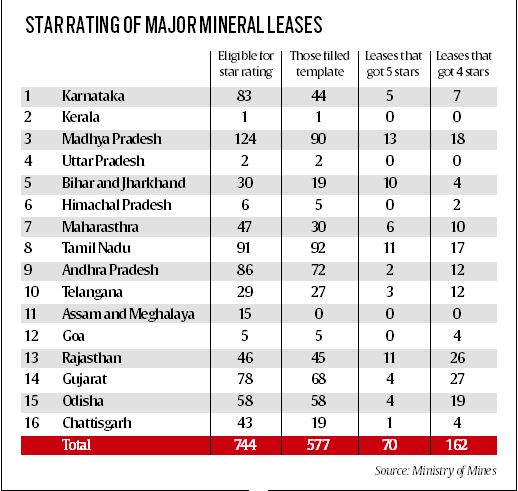Date | July 04, 2017:
After issuing the evaluation template in May last year to provide star ratings to leases of major minerals such as iron ore and coal, the Central government has now initiated the process to create a similar template for leases of minor minerals such as clay and sand.
“The credence of the star rating system for major minerals in the implementation of the Sustainable Development Framework (SDF) and fostering adoption of best practices has encouraged the state governments for adopting the system for minor minerals as well. Most states expressed their interest in meetings taken by Union mines secretary on June 2 and June 16 — of the major mineral rich states and other states, respectively — to adopt the star rating system for minor minerals,” said Niranjan Kumar Singh, joint secretary, Union mines ministry, in a letter written to principal secretary of each state’s mineral department, on June 28.
The draft evaluation template for star rating of minor mineral leases has been sent to each state government for comments. This minor minerals draft template is much smaller and simpler than the 12-page final template that was issued on May 23 last year for major minerals. The minor minerals draft template is of four pages only. In India, the classification of ‘minor minerals’ and ‘major minerals’ has been done according to Mines and Minerals (Development and Regulation) Act, 1957.
The draft evaluation template for minor mineral leases consists of various parameters for which different sets of points would be given. In total, there are 100 points that can be scored by the mining lease area. 28 points have been allotted to parameters related to ‘systematic and sustainable mining’, 15 points have been allotted to parameters related to ‘protection of environment’ and 10 points have been allotted to parameters related to ‘conservation of water and use of renewal energy sources’. ‘Health and safety of workers’, ‘welfare measures and community engagement’, and ‘statutory compliance’ were given 20, 13 and 14 points, respectively.

For instance, under the category of ‘statutory compliance’, there are three parameters. First one is if the mining lease area has all the no-objection certificates (NOCs) and required certificates from the government departments. If the answer is yes, 5 points would be awarded to the lease area. Second is if the compliance has been done after the violations were pointed out by any government agency such as state pollution control board. Here too, if the answer is yes, 5 points would be awarded. Third parameter is whether the lease area has appointed competent persons — such as manager, foreman, mining mate and blaster — as per the statute. The names of such persons have to be given by the lease holder and if the answer is yes, 4 points would be provided. In this way, statutory compliance has total 14 points.
Under the category of ‘systematic and sustainable mining’, if the mining area of the minor mineral has dust suppression measures or ventilation measures as per the Metalliferous Mines Regulations, 1961, it would get 5 points. If the general cleanliness in the mining premises — which includes in-site office, working sites and roads — is ‘excellent’, the mining area would get 3 points. However, if the general cleanliness is ‘moderate’, only 2 points would be given. No points would be awarded for ‘poor’ ranking in general cleanliness. In total, ‘systematic and sustainable mining’ has total 28 points that can be earned by getting positive answers on six such parameters.
As per the draft evaluation template, if the lease area scores more than 75 points in its evaluation, it would be given 5-star rating. If it scores anywhere between 60-75, it would be given 4-star rating. A score in between 50-60 would fetch 3-star rating. A meeting of executive committee, which had also prepared the evaluation template last year for star rating of major minerals, met on June 9 this year to prepare this similar draft template for minor minerals.
This issue of preparation of evaluation template for star rating of minor minerals was also discussed during the Central Coordination-cum-Empowered Committee (CCEC) meeting that was held on June 2, 2017. Of the 16 mineral rich states that participated at the CCEC meeting, 11 said yes when they were asked if they would adopt the star rating system for minor minerals, too.
According to data from the mines ministry, total 744 mining leases of major minerals, belonging to 16 mineral rich states (see table), are eligible for star rating. Out of those 744 leases, 577 have filled up the information in the template and submitted it online.
(Source: http://indianexpress.com/)